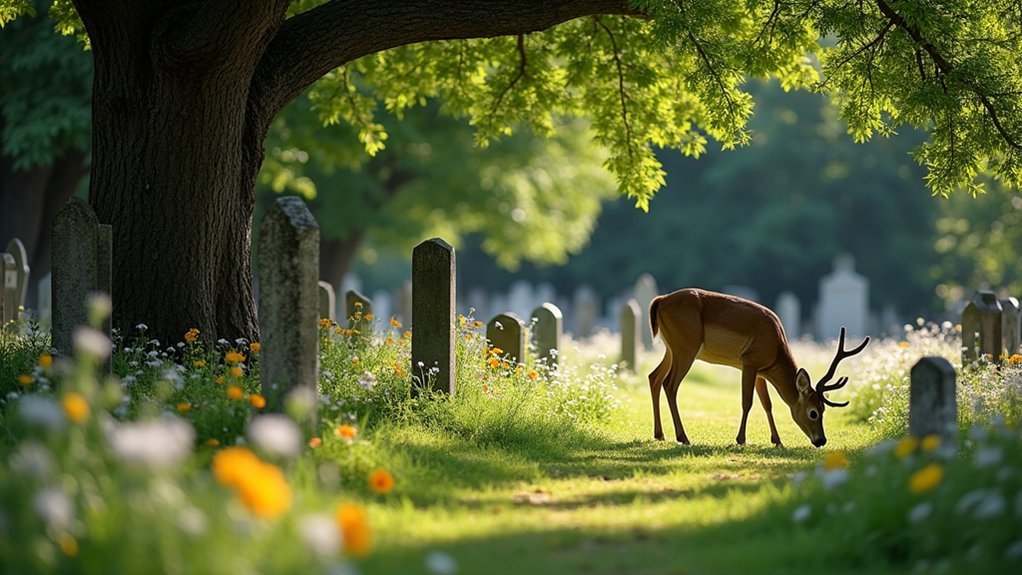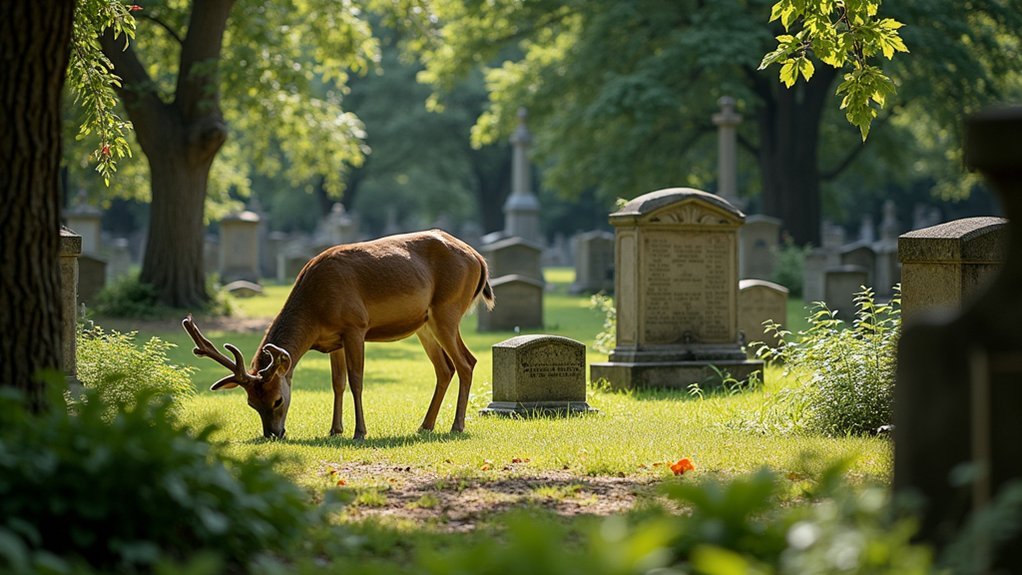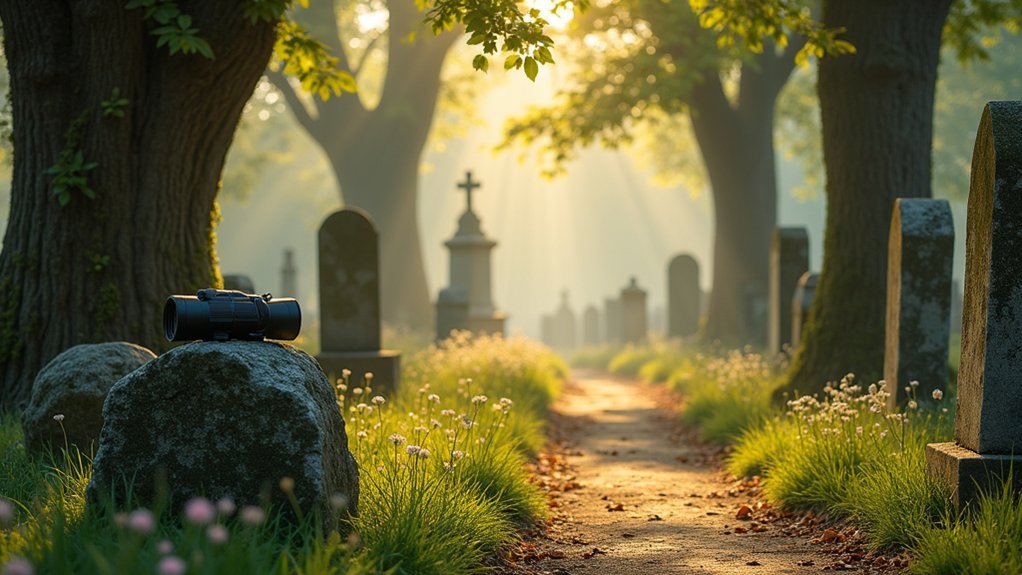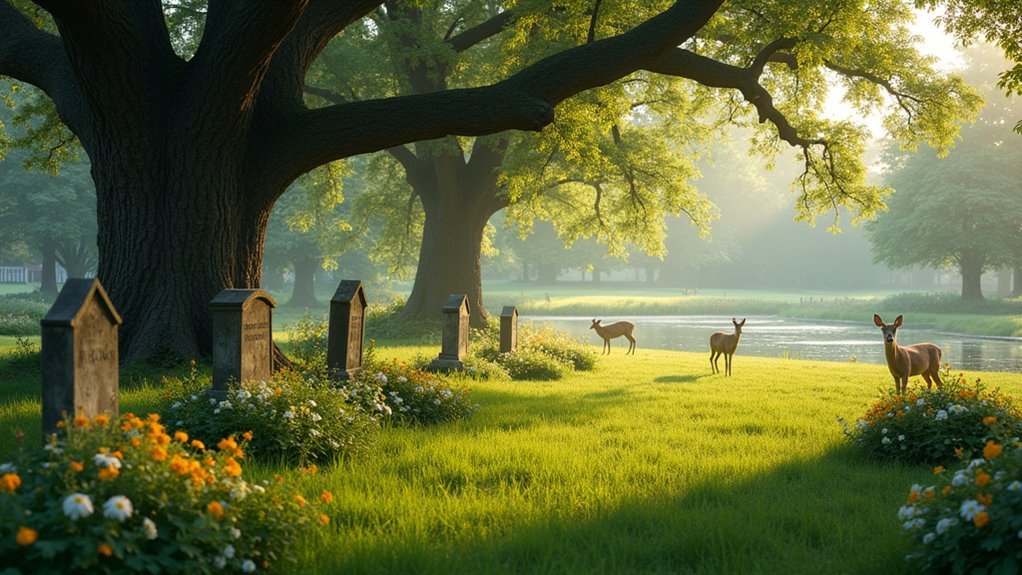When wildlife watching in cemeteries, stay on marked paths, speak softly, and use binoculars rather than approaching animals directly. Respect sacred spaces by avoiding stepping on graves and keeping a considerate distance from mourners. Visit during early morning or late afternoon when wildlife is most active, and never use flash photography. Remember that photography requires sensitivity—always seek permission near gravesites. These guidelines help balance your nature appreciation with the cemetery’s primary purpose as a place of remembrance.
Observing Wildlife Without Disturbing Sacred Grounds

While cemeteries offer unique habitats for wildlife observation, they remain sacred grounds that deserve our utmost respect.
When visiting a cemetery for wildlife watching, stay on designated paths to protect both the habitat and burial sites. Keep your voice low and avoid sudden movements that might startle birds or other animals.
Pay close attention to your surroundings, noticing how your presence affects the wildlife. Instead of approaching animals for a closer look, use binoculars to observe from a respectful distance.
Never touch or pick plants, as they provide essential food and shelter for cemetery wildlife.
Remember that your primary obligation as a visitor is to maintain the cemetery’s sacred atmosphere, balancing your interest in nature with respectful behavior toward those who are memorialized there.
Seasonal Bird Species to Expect in Cemetery Settings
Cemetery habitats transform throughout the year, becoming temporary homes for an impressive variety of seasonal birds. As you visit these burial grounds, you’ll discover urban cemeteries offer diverse habitats that attract distinct seasonal bird species during spring and fall migrations.
- Spring Migration: Watch for colorful Cerulean Warblers and songbirds as they rest among the trees surrounding final resting places.
- Water Features: Ponds and fountains draw migratory birds like herons and ducks, creating unexpected wildlife hotspots.
- Year-Round Residents: Raptors including hawks and owls often nest in cemetery trees, while unique visitors like Evening Grosbeaks and Monk Parakeets may appear in certain locations.
The bird populations you’ll encounter change with the seasons, making each cemetery visit a new opportunity to connect with nature’s rhythms.
Balancing Photography Ethics With Memorial Respect

Capturing beautiful wildlife moments in cemetery settings requires a delicate balance between your photography passion and respect for sacred spaces.
Always ask permission before photographing near a loved ones grave, as families deserve privacy during their time of remembrance.
Respect mourners’ space by seeking permission before capturing images near gravesites where families honor their departed.
When visiting a burial ground, refrain from using flash photography, which can disturb both wildlife and mourners.
Cemetery Etiquette demands paying attention to your surroundings, maintaining a hushed voice, and being mindful of others who may be grieving nearby.
It’s a good idea to familiarize yourself with posted rules before taking any photos, as policies differ between cemeteries.
Remember that your primary focus should be respectful documentation—never compromise someone’s privacy or the dignity of memorials for the sake of a perfect wildlife shot.
Proper Timing and Locations for Cemetery Wildlife Viewing
Knowing when and where to observe wildlife in cemetery settings enhances both your experience and guarantees minimal disruption to these sacred grounds.
For ideal wildlife viewing, visit during early morning or late afternoon when animals are most active. Urban cemeteries become especially vibrant during spring and fall migration seasons, offering exceptional opportunities to spot diverse migratory birds.
- Seek out water features and mature tree stands within the cemetery grounds, as these microhabitats attract the greatest biodiversity.
- Visit notable cemeteries like Mount Auburn in Massachusetts, which offers specialized birding walks during peak seasons.
- Adjust your expectations seasonally—winter visits may reward you with sightings of raptors and waterfowl in cemeteries with unfrozen water features.
Interacting With Other Visitors While Bird Watching

While pursuing your bird watching interests in cemetery grounds, you’ll inevitably encounter other visitors whose purposes vary widely from mourning loved ones to appreciating historical monuments.
Maintain a respectful distance from others, particularly those who appear to be in mourning or reflection.
As you navigate the grounds, avoid stepping on graves and always respect the sanctity of the area by staying on designated paths.
When fellow bird enthusiasts approach, keep conversations brief and speak in hushed tones. If someone inquires about your observations, respond courteously without dominating the interaction.
Position your equipment thoughtfully to avoid blocking pathways, and always allow visitors unobstructed access to gravesites and memorials.
Remember that while you’re enjoying nature, others may be experiencing profound moments of grief or remembrance.
Frequently Asked Questions
What Is the Etiquette for Visiting a Cemetery?
Speak softly, follow posted rules, and respect visiting hours. Don’t touch gravestones or remove items left at graves. Stay on paths, avoid stepping on graves, and ask permission before photographing. You’re there to honor the deceased.
How to Respectfully Visit a Cemetery?
You should walk on designated paths, speak softly, check cemetery rules before visiting, avoid stepping on graves, and clean up after yourself. Don’t bring noisy devices, and consider quiet activities like prayer or journaling.
What Is the Safe Distance From Wildlife?
You should stay at least 50 yards (150 feet) from larger animals like bears and deer, and 25 yards (75 feet) from smaller wildlife. Use binoculars or zoom lenses to observe without disturbing them.
What Not to Do at a Cemetery?
You shouldn’t touch or climb on gravestones, speak loudly, leave food items, take photos without permission, or step on graves. These actions are disrespectful to the deceased and their families and may damage memorials.
In Summary
You’ll enhance your cemetery wildlife experience by following these respectful practices. Remember that you’re visiting hallowed ground where others mourn and reflect. Observe birds from a distance, time your visits appropriately, and always yield to mourners. By balancing your enthusiasm for nature with reverence for the sacred space, you’ll enjoy meaningful wildlife encounters while honoring the cemetery’s primary purpose.





Leave a Reply